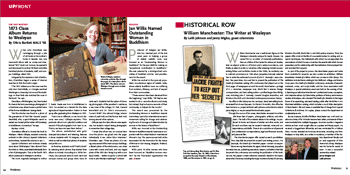THE “WU” MYSTERY
 When John Chambless was rummaging through a pile of old books at his mother’s home in Newark, Del., one mammoth album with an ornate and intertwined “WU” stuck out. Curious, he opened it and discovered more than 50 black and white hand–laid photos of students, staff, and campus buildings, dated 1873.
When John Chambless was rummaging through a pile of old books at his mother’s home in Newark, Del., one mammoth album with an ornate and intertwined “WU” stuck out. Curious, he opened it and discovered more than 50 black and white hand–laid photos of students, staff, and campus buildings, dated 1873.
Intrigued by the mysterious lack of attribution, Chambless began a series of Internet searches to find the book’s origin.
“The ‘WU’ reference on the cover was the only clue I had initially, so I Google–searched Washington University, but none of the buildings on their Web site matched the ones in the book,” he says.
Chambless, of Wilmington, Del., then looked for clues in the book, examining a photograph of a downtown area, where he saw a partial name of the former Middletown Savings Bank.
“But the clincher was found in a photo of the gravestone of Civil War General Joseph Mansfield, who, a quick Wikipedia search revealed, was buried (at the Indian Hill Cemetery) in Middletown, Connecticut,” he says.
Mystery solved.
Chambless offered to donate the book to Wesleyan. Valerie Gillispie, assistant university archivist in Olin Library’s Special Collections and Archives, received the volume on Jan. 5.
Special Collections and Archives already owns about 150 Wesleyan “class albums” from the 1850s to 1890s, assembled individually from a list of photographs. This is the fourth 1873 album preserved in Wesleyan’s archives.
The book originally belonged to Arthur T. Neale. Neale was born in Middletown in 1852. He worked as a chemist for the State Agricultural Experimentation Station in New Jersey after graduating from Wesleyan in 1873.
“Each one is different, so we love to discover new ones,” Gillispie explains. “This particular album is in splendid condition and several of the photographs look ‘new’ to us. That is, we have not seen them before.”
The album, embellished with goldstamped decorations and lettering, features a dozen students with ’73 insignias on their shirts as well as individual photos of students and professors.
At the time, students could “build a book” by selecting which photos they wanted their album to include. According to a 1870s brochure, class pictures were 25 cents each and campus scenes and group shots were 35 cents each. Students had the option of choosing photographs of the president’s residence; a rear view of the college; Dr. Fisk, General Mansfield and Dr. Olin’s monuments; “Lover’s Walk”; the railroad bridge; interior views of Judd Hall; and the former Rich Hall, among several other options.
Gillispie says the class albums were expensive, but students valued having photographs to remember their college days.
“I knew this album was an unusual item since the photos are glued onto the pages individually. It was rather labor intensive,” Chambless says. “There are photos of a rowing crew, several of the main campus buildings, a distant photo of the whole town, one street scene with a store and bank, and one staged photo of the 1873 class living it up with a corn liquor bottle . . . Rather risqué for a school with roots in John Wesley’s teachings!” UPFRONT
